Section 4.6. Neighbor Discovery (ND)
4.6. Neighbor Discovery (ND)Neighbor Discovery (ND) is specified in RFC 2461. The specifications in this RFC relate to different protocols and processes known from IPv4 that have been modified and improved. New functionality has also been added. It combines Address Resolution Protocol (ARP) and ICMP Router Discovery and Redirect. With IPv4, we have no means to detect whether a neighbor is reachable. With the Neighbor Discovery protocol, a Neighbor Unreachability Detection (NUD) mechanism has been defined. Duplicate IP address detection (DAD) has also been implemented. IPv6 nodes use Neighbor Discovery for the following purposes:
The following improvements over the IPv4 set of protocols can be noted:
This summary gives an idea of what can be expected from this part of the specification. Now let's discuss the different processes in detail. The Neighbor Discovery protocol consists of five ICMP messages: a pair of Router Solicitation/Router Advertisement messages, a pair of Neighbor Solicitation/Neighbor Advertisement messages, and an ICMP Redirect message (refer to Table 4-2 earlier in this chapter for a summary of ICMP informational message types). To summarize, the Neighbor Discovery Protocol (NDP) specification is used by both hosts and routers. Its functions include Neighbor Discovery (ND), Router Discovery (RD), Address Autoconfiguration, Address Resolution, Neighbor Unreachability Detection (NUD), Duplicate Address Detection (DAD), and Redirection. 4.6.1. Router Solicitation and Router AdvertisementRouters send out Router Advertisement messages at regular intervals. Hosts can request Router Advertisements by issuing a Router Solicitation message. This will trigger routers to issue Router Advertisements immediately, outside of the regular interval. The format is shown in Figure 4-10. Figure 4-10. Router Solicitation message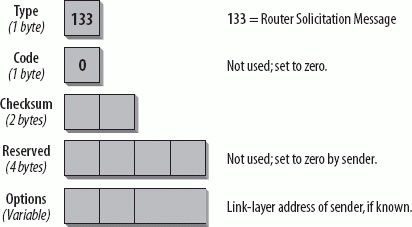 In the IP header of a Router Solicitation message, you will usually see the all-routers multicast address of FF02::2 as a Destination address. The hop limit is set to 255. The ICMP Type field is set to 133, which is the value for the Router Solicitation message. The Code field is unused and set to 0. The following two bytes are used for the Checksum. The next four bytes are unused and reserved for future use. The sender sets them to 0, and the receiver ignores those fields. For a Router Solicitation message, a valid option is the link-layer address of the sending host, if the address of the sending host is known. If the Source address on the IP layer is the unspecified (all-zeros) address, this field is not used. More options may be defined in future versions of ND. If a host cannot recognize an option, it should ignore the option and process the packet. Routers that receive this Solicitation message reply with a Router Advertisement message. Routers also issue those messages periodically. The format of the Router Advertisement message is shown in Figure 4-11. Figure 4-11. Router Advertisement message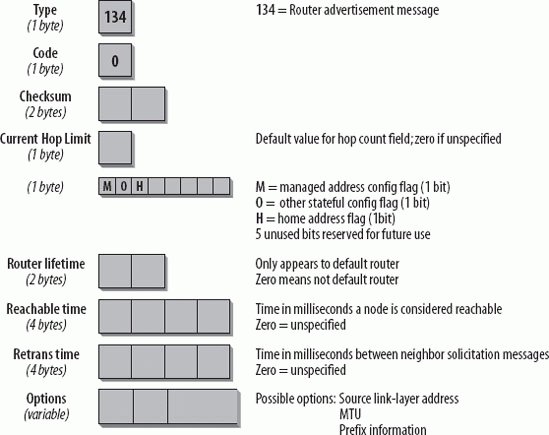 By inspecting the IP header of the Router Advertisement message, you can determine whether this Router Advertisement is periodic or was sent in reply to a Solicitation message. A periodic advertisement's Destination address will be the all-nodes multicast address FF02::1. A solicited advertisement's Destination address will be the address of the interface that originated the solicitation message. Again, the hop limit is set to 255. The ICMP Type field is set to 134, the value for a Router Advertisement message; the Code field is unused and set to 0. The Current Hop Limit field can be used to configure all nodes on a link for a default hop limit. The value entered in this field will be used as a default hop limit value in outgoing packets by all nodes on the link. A value of 0 in this field means that this option is unspecified by this routerin which case the default hop limit values of the source hosts are used. The next 1-bit field, the M flag, specifies whether Stateful configuration is to be used. Stateful configuration refers to what we know as DHCP with IPv4. If this bit is 0, the nodes on this link use Stateless autoconfiguration. If the bit is set to 1, it specifies Stateful autoconfiguration. The O-flag configures whether nodes on this link use Stateful configuration other than IP address information. A value of 1 means the nodes on this link use Stateful configuration for non-address-related information. The Mobile IPv6 specification (RFC 3775) defines the third bit, the home address flag (H-flag). When a router sets the H-flag to 1, it means that it is a home agent for this link. For a discussion of Mobile IPv6, refer to Chapter 11. The remaining five bits of this byte are reserved for future use and must be 0. The Router Lifetime field is important only if this router is to be used as a default router by the nodes on the link. A value of 0 indicates that this router is not a default router and will therefore not appear on the default router list of receiving nodes. Any other value in this field specifies the lifetime, in seconds, associated with this router as a default router. The maximum value is 18.2 hours. There is an optional extension to the Router Advertisement message, which allows routers to advertise preferences and more specific routes. This makes it possible for hosts to choose the best router in situations where they receive more than one router advertisement. It is also important for multihomed routers, which will be an increasingly important scenario in the IPv6 network. This extension uses the two bits after the H-flag in the router advertisement as a Preference flag and defines a Route Information option. It is specified in RFC 4191. The Reachable Time field indicates the time in which a host assumes that neighbors are reachable after having received a reachability confirmation. A value of 0 means that it is unspecified. The Neighbor Unreachability Detection algorithm uses this field. The Retrans Timer field is used by the address resolution and Neighbor Unreachability Detection mechanisms; it states the time in milliseconds between retransmitted Neighbor Solicitation messages. A value of 0 indicates that this router is not configured with a retransmission timer. For the Options field, there are currently three possible values:
More options may be defined in future versions of ND. A trace file later in this chapter shows what the options look like. 4.6.2. Neighbor Solicitation and Neighbor AdvertisementThis pair of messages fulfills two functions: the link-layer address resolution that is handled by ARP in IPv4, and the Neighbor Unreachability Detection mechanism. If the Destination address is a multicast address (usually the solicited node multicast address), the source is resolving a link-layer address. If the source is verifying the reachability of a neighbor, the Destination address is a unicast address. This message type is also used for Duplicate IP Address Detection (DAD). The format of the Neighbor Solicitation message is shown in Figure 4-12. Figure 4-12. Format of the Neighbor Solicitation message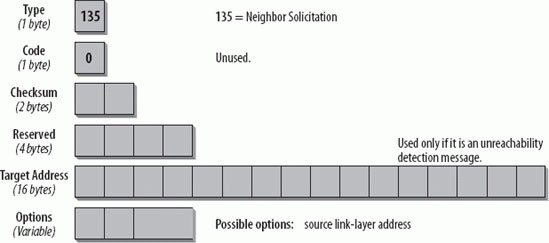 In the IP header of this message type, the Source address can be either the interface address of the originating host or, in the case of Stateless autoconfiguration and DAD, the unspecified (all-zeros) address. The hop limit is set to 255. The Type field in the ICMP header is set to 135, and the Code field is unused and set to 0. After the two checksum bytes, four unused bytes are reserved and must be set to 0. The target address is used in Neighbor Advertisement and Redirect messages. It must not be a multicast address. The Options field can contain the link-layer Source address, but only if it is not sent from the all-zeros address. During Stateless autoconfiguration, in a message that uses the unspecified address as a Source address, the Options field is set to 0. The link-layer option must be used in multicast solicitations (link layer address detection) and can be used in unicast solicitations (Unreachability Detection). Neighbor Advertisement messages are sent as a reply to Neighbor Solicitation messages or to propagate new information quickly. The format of the message is shown in Figure 4-13. Figure 4-13. Format of the Neighbor Advertisement message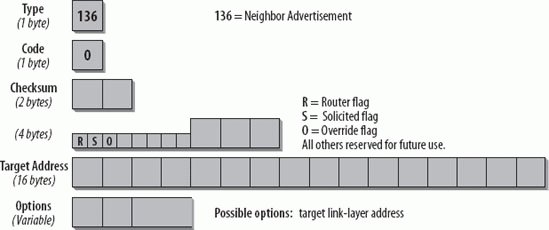 The type of address in the IP header indicates whether the message is the answer to a solicitation or an unsolicited message. In the case of a solicited advertisement, the destination IP address is the Source address of the interface that sent the solicitation. If the message is the reply to a DAD message that originated from an unspecified Source address, the reply will go to the all-nodes multicast address of FF02::1. The same is true for all unsolicited periodic advertisements. The Type field in the ICMP header is set to 136, the value for Neighbor Advertisement messages. The Code field is unused and set to 0. When the Router flag is set, the sender is a router. When the Solicited flag is set, the message is sent in response to a Neighbor Solicitation. For instance, if a host confirms its reachability in answer to an unreachability detection message, the S bit is set. The S bit is not set in multicast advertisements. The Override flag indicates that the information in the Advertisement message should override existing Neighbor Cache entries and update any cached link-layer addresses. If the O bit is not set, the advertisement will not update a cached link-layer address, but it will update an existing Neighbor Cache entry for which no link-layer address exists. The O bit should not be set in an advertisement for an anycast address. I discuss the cache entries later in this chapter. The remaining 29 bits are reserved for future use and set to 0. In solicited advertisements, the Target Address contains the address of the interface that sent the solicitation. In unsolicited advertisements, this field contains the address of the interface whose link-layer address has changed. A possible option for the Options field is the target link-layer address. Table 4-6 helps you to identify what you are looking at and summarizes the different processes.
4.6.3. The ICMP Redirect MessageRouters issue ICMP Redirect messages to inform a node of a better first-hop node on the path to a given destination. A Redirect message can also inform a node that the destination used is in fact a neighbor on the same link and not a node on a remote subnet. The format of the ICMPv6 Redirect message is shown in Figure 4-14. Figure 4-14. Format of the ICMP Redirect message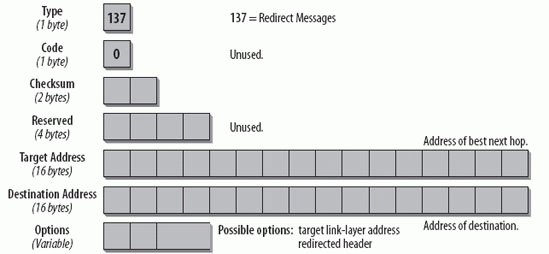 The Source address in the IP header must be the link-local address of the interface from which the message is sent. The Destination address in the IP header is the Source address from the packet that triggered the redirect message. The hop limit is set to 255. The Target Address field contains the link-local address of the interface that is a better next-hop to use for the given Destination address. The Destination Address field contains the address of the destination that is redirected. If the address in the Target Address field is the same as the address in the Destination Address field, the destination is a neighbor and not a remote node. The Options field contains the link-layer address for the target (the best next-hop router) if it is known. This is an improvement on the IPv4 version, in which the host needed to issue a separate ARP request to determine the link-layer address of the next-hop router. The remaining bits in the options field contain as much of the redirected header as fits into the minimum IPv6 MTU of 1,280 bytes. 4.6.4. Inverse Neighbor DiscoveryInverse Neighbor Discovery (IND) is an extension to ND. It was originally designed for Frame Relay networks, but it can be used in other networks with similar requirements. IND is specified in RFC 3122. It consists of two messages: the IND Solicitation and the IND Advertisement message. The messages are used to determine the IPv6 address of hosts for which the link layer address is known. IND corresponds to the Reverse Address Resolution Protocol (RARP) used with IPv4. The messages have the same format as the ND messages. The IND Solicitation has a message type of 141 and the IND Advertisement of 142. The code field is always set to 0. The Options field has the same format as in the ND messages and contains the same options. Two new IND-specific options have been defined. Option Type 9 defines the Source Address list; option Type 10 the Target Address list (see the overview in Table 4-7).
When a host wants to determine the IPv6 address of an interface for which it knows the link-layer address, it sends an IND solicitation to the all-nodes multicast address. On the link layer, the message is sent directly to the interface in question. The destination replies with an IND advertisement containing the Target Address list. If the interface has more IPv6 addresses than fit into a single advertisement message, it must send multiple IND advertisements. Like in all other ND messages, the hop limit is set to 255, and messages with a hop limit lower than 255 must be ignored. 4.6.5. Neighbor Discovery OptionsNeighbor Discovery messages contain a variable-size Options field that has the format shown in Figure 4-15. Figure 4-15. Format of the Option field The Type field indicates what type of option follows. The following types are defined in RFC 2461:
The Length field indicates the length of the option. Value 0 is invalid for this field, and packets with this value must be discarded. The calculation of the length includes the Type and Length fields. Table 4-7 shows an overview of the different options and the message types in which they are used.
4.6.6. Secure Neighbor DiscoveryND can be used for a number of attacks and should therefore be protected. An example of a Denial of Service attack is when a node on the link can both advertise itself as a default router and also send "forged" Router Advertisement messages that immediately time out all other default routers as well as all on-link prefixes. The first protection is that packets coming from off-link (with a hop limit lower than 255) must be ignored. Further, the original ND specification suggests using IPsec to secure ND messages. However, this requires manual setup of security associations or the use of a key management protocol. The number of security associations to be configured for protecting ND can be very large, so this approach may be impractical. The Secure Neighbor Discovery (SEND) working group was chartered with the goal to define the protocol support needed to secure ND. Three different trust models were outlined, roughly corresponding to secured corporate intranets, public wireless access networks, and pure ad hoc networks. A number of possible threats are discussed relating to these trust models. Refer to RFC 3756 for more details. The SEND protocol, defined in RFC 3971, is designed to counter the threats to ND. SEND can be used in environments where physical security on the link is not assured (such as over wireless) and attacks on ND are a concern. The following components are specified in RFC 3971:
The SEND protocol uses Cryptographically Generated Addresses. SEND currently does not support the protection of ND messages for nodes configured with a static address or with addresses configured through IPv6 Stateless autoconfiguration mechanisms. All new option types and messages are specified in RFC 3971. Cryptographically Generated Addresses (CGA) are specified in RFC 3972, which defines a method for binding a public signature key to an IPv6 address in the SEND protocol. CGA are IPv6 addresses for which the interface identifier is generated by computing a cryptographic one-way hash function from a public key and auxiliary parameters. 4.6.7. ND in the Trace FileAt this point, you all deserve a refreshment. The following trace file shows what ND looks like in the real world and illustrates what we have been talking about. The screenshot in Figure 4-16 shows the details of a Router Advertisement with two Option fields. This trace file was taken when we had just set up our router. Besides initializing the IPv6 stack and configuring it for the prefix, we have not changed any of the configuration parameters. The options used in this case are options 1 (source link-layer address) and 3 (prefix information). Note the format of the Option fields. Figure 4-16. The Router Advertisement in a trace file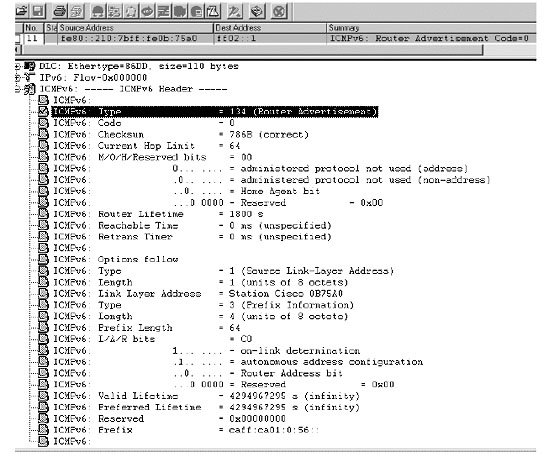 The Type field is set to 134, the value for a Router Advertisement. The Current Hop Limit has a value of 64. All nodes on this link will use this value for their Hop Count field. The M and O flags are not set by default. The Router Lifetime is set to 1800, which indicates that this is a default router. The first Option listed is type 1. The link-layer address in the detail screen contains the link-layer address of the router interface. The second Option is of type 3 for prefix information. Note all the additional information that can be given with a prefix. The Prefix Length field specifies the number of bits valid for the prefix (i.e., the length of the subnet mask). The L bit is the on-link flag. If set, it indicates that this prefix can be used for on-link determination. If it is not set, the advertisement does not make a statement, and the prefix can be used for on- and off-link configuration. The A bit is the autonomous address configuration flag. If set, it indicates that the prefix can be used for autonomous address configuration. In this case, the host will generate an address by adding the interface identifier to the prefix or, if the privacy options are used, by adding a random number. The Valid Lifetime field specifies how long this prefix is valid. A value of all Fs means infinity. The Preferred Lifetime specifies how long the address being configured with this prefix can remain in the preferred state. Here as well, a value of all Fs means infinity. The last field shows the prefix of caff:ca01:0:56:: advertised by this router. 4.6.8. Link-Layer Address ResolutionLink Layer Address Resolution is the process that happens when a node wants to determine the link-layer address of an interface for which it knows the IP address. With IPv4, this is the functionality of ARP. Link Layer Address Resolution is performed only for nodes that are known to be on the same link (neighbors) and is never performed for multicast addresses. With IPv6, this is a functionality accomplished with ND messages. A node wanting to resolve a link layer address sends a Neighbor Solicitation message to the solicited node multicast address of the neighbor. This solicitation message contains the link-layer address of the sender in the ND option field. If the destination is reachable, it replies with a Neighbor Advertisement message containing its link-layer address. If the resolving node does not receive an answer within a preconfigured number of attempts, the address resolution has failed. 4.6.9. Neighbor Unreachability Detection (NUD)A neighbor is considered reachable if the node has recently received a confirmation that packets sent to the neighbor have been received by its IP layer. This confirmation can come in one of two ways: it can be a Neighbor Advertisement in response to a Neighbor Solicitation, or it can be an upper-layer process that indicates the successful connection (e.g., an active TCP connection). In this case, the receipt of TCP acknowledgements implies the reachability of the neighbor. To keep track of active and reachable connections, IPv6 nodes use different tables. Two important tables relating to ND are the Neighbor and Destination Caches, which I discuss in the next section. 4.6.10. Neighbor Cache and Destination CacheIPv6 nodes need to maintain different tables of information. Among these tables, the Neighbor Cache and Destination Cache are particularly important. Depending on the IPv6 stack you are working with, the implementation and the troubleshooting utilities will be different. But the information must be available on every IPv6 node.
The Neighbor and Destination Caches have been mentioned in regard to the Override flag that can be set in a Neighbor Advertisement message. If the Override flag is set, the information in the Advertisement message should override existing Neighbor Cache entries and update any cached link-layer addresses in the cache of the host that receives the advertisement. If the O bit is not set, the advertisement will not update a cached link-layer address, but it will update an existing Neighbor Cache entry for which no link-layer address exists. The screenshot in Figure 4-17 shows the Neighbor Cache entries of our Cisco router. There were two hosts on the link at the time the screenshot was taken. Figure 4-17. Neighbor Cache entries on a router According to RFC 2461, a Neighbor Cache entry can be in one of five states. The five states are explained in Table 4-8.
If you are interested in the details about the timers, default values, and configuration options, refer to RFC 2461. |